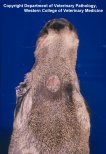| Ringworm |
 |
 |
|
| |
| Causative Agent |
-
A potentially
zoonotic disease of the skin, hair
or nails caused by one of several species of
fungi (dermatophytes). Some of
these
fungi are adapted to soils (e.g.,
Microsporum gypseum), others to animals and humans (e.g.,
M. canis, Trichophyton verrucosum). Both can potentially
cause disease in animals and humans.
-
Despite the name, worms have
nothing to do with this disease.
|
| Images |
|
Click on
image to
enlarge. |
 |
|
Characteristic ringworm
lesions are often round, devoid of hair and red in color, as
demonstrated in this mule deer. |
|
| Distribution |
|
Geographic: |
|
|
|
Seasonality: |
-
Fungal
spores can remain viable for
extended periods in the environment.
|
|
| Hosts, Transmission and Life
Cycle |
| Hosts: |
-
Humans and wild mammals: in BC, ringworm has been reported in
black-tailed and mule deer (Odocoileus
hemionus), and small carnivores.
-
Young mammals and those suffering from other diseases or with reduced
immunological competence may be prone to
severe ringworm infection.
-
Some species of
fungus are
well adapted to specific species hosts and these hosts may
not have symptoms. Such species can act as
reservoirs of infection.
|
|
Transmission and Life Cycle: |
-
Transmission occurs through direct contact with
fungal
material on carrier animals
or contact with
fungal spores from objects (fomites), such as feed, bedding, etc., especially on abraded skin.
-
Ringworm infection is usually self-limiting, with
lesions taking a few weeks to
several months to regress, depending on the
fungal species, degree of host
adaptation and response of the individual host. Secondary
bacterial infections of the skin can
be extensive and debilitating.
|
|
| Signs and Symptoms |
-
Ringworm skin
lesions
typically begin as distinct, round areas of hair loss, which may
then progress to skin reddening, thickening and loss of
pigmentation.
-
Breakage of the hair shaft and subsequent hair loss is accomplished
by
fungal
elements entering the shaft of the hair itself, rendering it
brittle.
|
| Meat Edible? |
-
Infected areas of the
skin should not be consumed.
|
| Human Health Concerns and
Risk Reduction |
-
Ringworm infection in
humans is similar to that in wildlife but infections may be more
severe.
-
Skin
lesions are
often red, expansive, and can vary from dry and scaly to moist and
seeping fluid. Lesions may also have a central healed zone
surrounded by expanded ring of infection, hence the name ringworm.
-
Rubber gloves should be worn when handling wildlife with skin
conditions. The area in which the infected animal was handled should
also be disinfected with household bleach in a 1:10 dilution.
-
Topical application of antifungal agents, sometimes for extended
periods, is the usual mode of treatment.
|
| Samples for Diagnosis |
-
Presence of
fungal
infection can be confirmed in the laboratory with skin samples, skin
scrapings, or hair samples.
|
| Similar Diseases |
|
|
| Further Reading |
|
|
|
|


